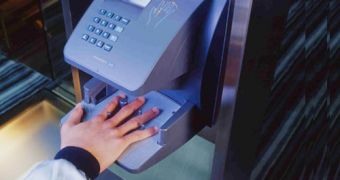Fingerprinting is probably the most widely used method of identifying individuals. The police uses this method to identify suspects by matching the fingerprints taken from a crime scene with those found in their databases, or with those of unrecorded suspects they encounter.
Reliability comes from the fact that two people on Earth cannot have the exact same fingerprint pattern and the technique has been used ever since the late 19th century.
Many private companies, as well as government agencies, use fingerprint scanners to make sure only authorized personnel has access to classified information.
Unfortunately, there are ways to fool a fingerprint scanner into believing the person trying to enter has the proper authorization. For instance, the fingerprint patterns can be copied and replicated into latex molds that can be worn on the finger or hand by an unauthorized person. Even worse, removing the entire finger or hand of the person having a clearance (whether he/she is dead or alive at the moment) and using it to fool the scanner is not unheard of.
Now, a new study by researchers from the University of Michigan in Ann Arbor has shown that 3D ultrasound of fingers could be used for biometric identification based on matching paired images using internal fingerprint structures that would be difficult to fake, offering the possibility of a unique automated fingerprint identification system.
The study used 3D images taken of the fingers of 20 volunteers and attempted to match the pairs based on anatomic and physiological features of the human finger. Two musculoskeletal radiologists analyzing the specimens have come up 100% successful.
"The purpose of the study was to evaluate whether the use of internal finger structure as imaged using ultrasound could act as a supplement to standard methods of biometric identification. Also, this study provides a way of assessing physiologic and cardiovascular status, for example, whether the person is alive or not, which is not known from just their external fingerprints. There is a wide range of applications for an inexpensive ultrasonic fingerprint reader, including widespread use in cell phones," according to Ganesh Narayanasamy, PhD candidate in Applied Physics and lead author of the study.
The applications are not limited to the security field, being of medical use, according to the authors. "This could become a method of patient identification and even continuous physiologic monitoring. The techniques should become useful for other types of musculoskeletal ultrasound and for monitoring of arthritis treatments," said Dr. Narayanasamy.

 14 DAY TRIAL //
14 DAY TRIAL //